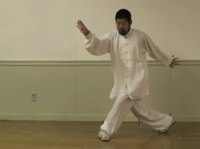Master Chen, I have a question for you related to the use of the dantian and coccyx. In reading the book “Chen Style Taijiquan Practical Method, Volume One: Theory” which you translated from Hong Junsheng’s writings, it says that the sinking of the qi to the dantian has a lot to do with the actions of the coccyx, and that the coccyx should actually curl up backwards.
I was practicing the positive circle this morning and noticed something related to this in regards to the three way split where the shoulder goes/pushes down, the waist goes to the side and the arm/hand goes forward. I always had a question about how to actually generate the down power/force or significant down power. By just trying to drop/sink the shoulder I didn’t seem to be able to generate enough. I had the question of was it just pushing/dropping the shoulder, or was it also the dropping of the right knee and subsequent opening of the left kua. Doing this I could get a downward feeling but not substantial and seemed to be more horizontal than vertical.
In practicing today I felt if I dropped the dantian, or rather pushed/pulled it down, then I could really feel the drop/compression and by not moving the front knee the split was more pronounced, especially if I kept the head suspended. Also, in doing the last part of the positive circle this also seemed to help open the back and create the three way split of the hand going forward the energy sinking down and the rear part going back. I then played around with the position of the coccyx and if I pushed it down and then slightly curling it back it seemed to stabilize/lock the whole dantian area where my stance was not floating as much. It seemed rather significant in keeping this part from moving which is something you refer to a lot.
Does this explanation sound correct for what i should be doing/experiencing? Is the pushing/pulling down of the dantian (while keeping the head suspended) key/important?
Thank you!
Gary Readore



{ 4 comments… read them below or add one }
Hi Gary,
I got the feeling that you are detailed oriented person and want to get everything right, when Master Chen was asked similar question in the last workshop, he replied that it is also important to regard the system holistically as expressed in the Yilu form
The detail of circles is in all 81 Yilu moves, and by practicing Yilu again and again the requirement becomes clear and I start working from my obvious mistakes to working on smaller ones.
You could tape your yilu and send it to Master Chen for comment ( his email is in his facebook ). You can see my Yilu progress videos in this post
http://practicalmethod.com/2010/07/full-time-yilu-record-wilkin
My yilu is still full of mistakes but I notice big difference between the first one and the last one
Thanks Wilkin:
Yes, I am pretty much a detailed oriented person, I guess it is the Engineer in me :). Your suggestion of taping my Yilu and sending it to Master Chen is a good idea. I am here in Houston, Texas so not readily accessible to Master Chen’s workshops. I am attempting to learn the Yilu form through the detailed videos. I have mainly been focusing on the positive and negative circles and just really started trying to learn the Yilu form so it will be a little while before I am ready to send a video. How long have you been studying with Master Chen?
I started with Master Chen early this year after practicing Yang style for two years.
The Dantian function is to connect the upper body with the lower body. In most cases, the Dantian should be lowered but that is only a practicality not a principle. The sequence is to feel that the Dantian sits on the kua while the kua is connected to the knee and then foot. The coccyx is important not because how it should move but rather because it is the helm of the body. It is like a rudder of a boat or the tail of a bird.